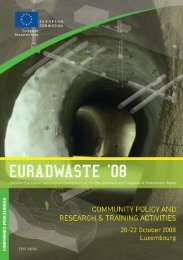EU industrial structure - EU Bookshop - Europa
EU industrial structure - EU Bookshop - Europa
EU industrial structure - EU Bookshop - Europa
Create successful ePaper yourself
Turn your PDF publications into a flip-book with our unique Google optimized e-Paper software.
Chapter IV — International competitiveness of <strong>EU</strong> industry<br />
box IV.4: trade in services: definition, sectoral breakdown and<br />
measurement 70<br />
International trade in services involves transactions between residents and non‑residents of an economy. Services<br />
are less tradable than goods. As they are immediately consumed, they cannot be resold. For many services, the<br />
consumer and provider of the service have to be located at the same place.<br />
From a sectoral perspective, the main components of services activities are generally broken down into three<br />
categories grouping together 11 types of services sectors:<br />
1. Transportation<br />
2. Travel.<br />
3. Other services, including: communication services, construction services, insurance services, financial services,<br />
computer and information services, royalties and licence fees, other business services, personal, cultural and<br />
recreational services and government services<br />
There are four modes for the supply of services:<br />
‑ Mode 1 is cross‑border supply, where only the service crosses the border. The change of country can, for<br />
example, be via electronic communication (Internet, telephone, facsimile, etc.). The sectors characterised by<br />
cross‑border supply are: most of transportation, communication services, financial and insurance services,<br />
royalties and licence fees. Parts of certain sectors can involve cross‑border supply: part of computer and<br />
information services, part of other business services, and part of personal, cultural and recreational services.<br />
‑ Mode 2 is consumption abroad, when consumers cross the border. This is the case principally for tourism or<br />
business travel, when individuals go to hotels and restaurants. Part of transportation can also be counted as<br />
consumption abroad (supporting and auxiliary services for carriers in foreign ports).<br />
‑ Mode 3 is commercial presence, when suppliers (firms) cross the border to supply services. A foreign<br />
company will, for example, open branches or subsidiaries in the destination country. Some construction services<br />
involve commercial presence.<br />
‑ Mode 4 is the presence of natural persons when suppliers (natural persons) cross the border to supply<br />
services. An individual who is self‑employed (for example a consultant or a health worker) or an employee (for<br />
instance a construction worker) moves temporarily to the country of the consumer to supply services. This form<br />
of trade is found in the following sectors: part of the computer and information services sector, part of ‘other<br />
business services’, part of the personal, cultural and recreational services sector, and part of the construction<br />
services sector.<br />
In this report, there is a gap between the conceptual classification of trade in services and the data that were used<br />
from the balance of payments statistics. Data on trade in services are more deficient than data on trade in goods.<br />
There are practical difficulties that arise when capturing trade in services. It is complicated to separate goods and<br />
services in the balance of payments. As a result, the latter may be under‑recorded. Moreover, certain transactions<br />
falling under the four modes of supply are not accounted for in the balance of payments estimates of services trade.<br />
Cross‑border trade (Mode 1) is the mode of supply best covered by the balance of payments statistics. Mode 2 —<br />
consumption abroad — is generally well covered as it is represented by expenditures in tourism and business travel.<br />
Trade through commercial presence (mode 3) is accounted for through company surveys (foreign affiliates trade in<br />
services surveys), which are a different type of statistics. The balance of payments takes into account residency rather<br />
than nationality: a service is considered as traded if it takes place between residents and non‑residents. In the case<br />
of trade through commercial presence (mode 3), there are only residents of the country who are involved. Mode 4 —<br />
presence of natural persons — is also badly covered.<br />
70 For more background, see European Commission, United Nations, International Monetary Fund, Organisation for Economic Cooperation<br />
and Development, United Nations Conference on Trade and Development, World Trade Organisation (2002) and WTO (2007).<br />
113
















